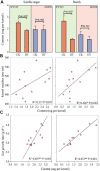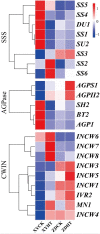Heat Stress After Pollination Reduces Kernel Number in Maize by Insufficient Assimilates
- PMID: 34691151
- PMCID: PMC8532994
- DOI: 10.3389/fgene.2021.728166
Heat Stress After Pollination Reduces Kernel Number in Maize by Insufficient Assimilates
Abstract
Global warming has increased the occurrence of high temperature stress in plants, including maize, resulting in decreased the grain number and yield. Previous studies indicate that heat stress mainly damages the pollen grains and thus lowered maize grain number. Other field studies have shown that heat stress after pollination results in kernel abortion. However, the mechanism by which high temperature affect grain abortion following pollination remains unclear. Hence, this study investigated the field grown heat-resistant maize variety "Zhengdan 958" (ZD958) and heat-sensitive variety "Xianyu 335" (XY335) under a seven-day heat stress treatment (HT) after pollination. Under HT, the grain numbers of XY335 and ZD958 were reduced by 10.9% (p = 0.006) and 5.3% (p = 0.129), respectively. The RNA sequencing analysis showed a higher number of differentially expressed genes (DEGs) between HT and the control in XY335 compared to ZD958. Ribulose diphosphate carboxylase (RuBPCase) genes were downregulated by heat stress, and RuBPCase activity was significantly lowered by 14.1% (p = 0.020) in XY335 and 5.3% (p = 0.436) in ZD958 in comparison to CK. The soluble sugar and starch contents in the grains of XY335 were obviously reduced by 26.1 and 58.5%, respectively, with no distinct change observed in ZD958. Heat stress also inhibited the synthesis of grain starch, as shown by the low activities of metabolism-related enzymes. Under HT, the expression of trehalose metabolism genes in XY335 were upregulated, and these genes may be involved in kernel abortion at high temperature. In conclusion, this study revealed that post-pollination heat stress in maize mainly resulted in reduced carbohydrate availability for grain development, though the heat-resistant ZD958 was nevertheless able to maintain growth.
Keywords: assimilates; heat stress; kernel abortion; maize; trehalose.
Copyright © 2021 Niu, Du, Wei, Liu, Tang, Bian, Zhang, Cui and Gao.
Conflict of interest statement
The authors declare that the research was conducted in the absence of any commercial or financial relationships that could be construed as a potential conflict of interest.
Figures









References
-
- Abendroth L. J., Roger W. E., Matthew J. B., Marlay S. K. (2011). Corn Growth and Development. Ames, Iowa: Iowa State University Extension.
-
- Ben-Asher J., Garcia y Garcia A., Hoogenboom G. (2008). Effect of High Temperature on Photosynthesis and Transpiration of Sweet Corn (Zea mays L. Var. Rugosa). Photosynt. 46, 595–603. 10.1007/s11099-008-0100-2 - DOI
-
- Berry J., Bjorkman O. (1980). Photosynthetic Response and Adaptation to Temperature in Higher Plants. Annu. Rev. Plant Physiol. 31, 491–543. 10.1146/annurev.pp.31.060180.002423 - DOI
LinkOut - more resources
Full Text Sources
Research Materials

